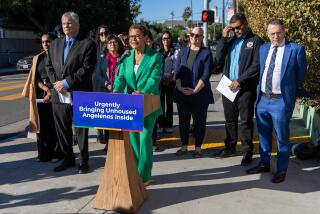Displaced Homemakers Mark Decade
- Share via
Ten years ago, two California women, Tish Sommers and Laurie Shields, coined the term displaced homemakers to describe a growing group of women--housewives and mothers who, because of divorce or a spouse’s death, must enter the work force to support themselves and their children.
The Oakland organization and movement they founded has grown to include the 10,000-member Older Women’s League and the Displaced Homemakers Network, a national umbrella group that encompasses more than 400 programs across the country that provide assistance to displaced homemakers and public education on their problems.
The network will celebrate its 10th anniversary with a conference Nov. 18-20 in Washington. Highlighting the event will be a luncheon honoring a successful displaced homemaker who supported her family by going to work in the garment industry when her husband died and reared a daughter who became the first woman to run for vice president. Congresswoman Geraldine Ferraro will join the Displaced Homemakers Network at the Nov. 20 luncheon honoring her mother, Antonetta Ferraro.
The conference will also get down to work in sessions that will address such issues as alimony and child support, employment and training, welfare, pensions, health issues and the concerns of older women.
“There is a new trend in the public policy reports reaching America today to paint a rosy picture of growing old in America,” Laurie Shields said in the conference material. “For women, the chances are still very great that growing old is going to mean growing poor. At any point, the death of a husband, an illness or job loss can upset the balance of finances for millions of American women who live on the edge. It is unfortunately still the case that many women are only a man away from poverty.”
There are about 4 million to 5 million career homemakers facing the job market out of necessity in the United States, the network estimates, and Jill Miller, executive director of the network, believes that the numbers of displaced homemakers may be increasing. “As the work force moves even more in the direction of new technologies, we may see even more women who, having ‘stepped out’ to raise their families suddenly discover that their outdated skills or education make them unemployable.”
National Council of Jewish Women, which sponsors a number of programs and support groups addressing women’s concerns, is starting something a little different--a weekly casual night out.
“Our Cafe,” which will open Thursday in the Women’s Center at Council House, 543 N. Fairfax, will be open from 7:30 to 9:30 p.m. every Thursday as a place where “women are welcome to drop in and, depending on how they feel and what they want, may socialize, read, have a cup of coffee, play a game of bridge or backgammon, or just hang out.”
There will be free parking in a well-lit lot next door.
A national reader survey by Working Mother magazine found that employers are more understanding than might have been thought about mothers who stay home from work with a sick child--and probably more flexible than the children’s fathers.
Of the 1,106 respondents, almost all of them mothers of children 8 and younger, 49% reported their bosses as “understanding and supportive” about time off for a child’s illness, and another 40% called their bosses “tolerant.” Only 6% said their supervisors give them a “hard time.” The survey was unduly weighted toward women with higher status jobs than would be found in the general population of women--half the respondents were in professional or executive posts.
When it comes to choices of who stays home with a sick child, mom’s the one. Seven out of 10 of the mothers in the survey did so. Two-thirds of the respondents said they stay home from one to five days a year to care for sick children. A large majority of the women in the study were married, but only one in four couples took turns staying home when the kids were sick. When children were slightly ill, 30% of the mothers turned to their mothers or mothers-in-law for care, but only six of 100 fathers routinely cared for slightly ill children, and that figure dropped to four in 100 when the child was seriously ill.
More to Read
Get the L.A. Times Politics newsletter
Deeply reported insights into legislation, politics and policy from Sacramento, Washington and beyond. In your inbox three times per week.
You may occasionally receive promotional content from the Los Angeles Times.










